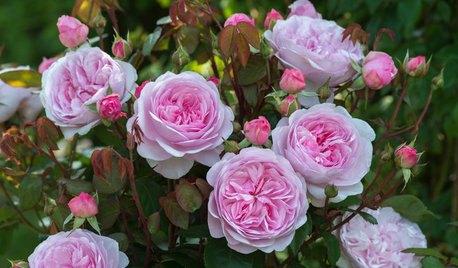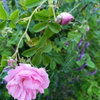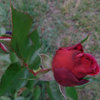Strange... Is Gruss an Aachen ever Cerise/Lavender?
kristimama
12 years ago
Related Stories

ROSES9 Roses That Landscape Designers Love
See which beautiful and reliable rose varieties are favored by designers around the country
Full StoryHi everyone,
I have a mystery.
Last year at the Celebration, I bought a small potted rose from the Heritage Rose Foundation's table labeled as "Gruss an Aachen." It was small so it hasn't given us much bloom this year, though we had a handful of small blossoms over the summer, mostly following the same pattern... the buds form as dark red/pink, and usually open up creamy white or light pink/yellow. This december, the same plant formed an ENORMOUS red bud, and when it opened it was dark pink/almost cerise and faded slightly lavender. Is this what Gruss does in cold weather?
It's also supposed to be a floribunda rose, and so far the way it has set flowers has been more like an HP or Bourbon or a tea, with one rose at the end of a long cane.
And it has the most outrageously beautiful smell...
Just because of the color, for a moment I thought I ended up with a Grandmother's Hat (which they were also selling last year), but that doesn't explain the white/creme roses earlier and it's not the right shape for a GramHat. And I suppose it could be pink gruss an aachen, but this flower was a much much darker pink than anything I've seen on the pink gruss an aachen.
Anyway, the color threw me off, and I didn't think about taking a photo before it finally crumbled away.
Have I got a mislabeled rose? Or does Gruss just continue to surprise us with a range of colors. (which is one of the reasons I bought it initially.)
Thanks,
Kmama






jerijen
Krista_5NY
Related Professionals
Marina Landscape Architects & Landscape Designers · Pottstown Landscape Contractors · Matthews Landscape Contractors · Berkley Landscape Contractors · Boca Raton Landscape Contractors · Fort Mill Landscape Contractors · Hoover Landscape Contractors · Lemay Landscape Contractors · Mendota Heights Landscape Contractors · West Coon Rapids Landscape Contractors · Selma Landscape Contractors · Bakersfield Swimming Pool Builders · Fallbrook Swimming Pool Builders · Leesburg Siding & Exteriors · Oak Forest Siding & Exteriorsmariannese
roselee z8b S.W. Texas
michaelg
jaxondel
carolinamary